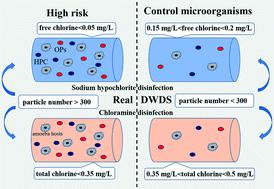当前位置:
X-MOL 学术
›
Environ. Sci.: Water Res. Technol.
›
论文详情
Our official English website, www.x-mol.net, welcomes your feedback! (Note: you will need to create a separate account there.)
Effects of disinfectants and particles on the occurrence of different microorganisms in drinking water distribution systems
Environmental Science: Water Research & Technology ( IF 5 ) Pub Date : 2021-4-2 , DOI: 10.1039/d0ew01119c Lixin Huo 1, 2 , Linlin Pan 2, 3 , Ruya Chen 2, 3 , Baoyou Shi 2, 3 , Haibo Wang 2, 3 , Shouyang He 1
Environmental Science: Water Research & Technology ( IF 5 ) Pub Date : 2021-4-2 , DOI: 10.1039/d0ew01119c Lixin Huo 1, 2 , Linlin Pan 2, 3 , Ruya Chen 2, 3 , Baoyou Shi 2, 3 , Haibo Wang 2, 3 , Shouyang He 1
Affiliation

|
The effects of disinfectants and particles on the occurrence of different bacteria, including total coliforms, heterotrophic plate count (HPC), different opportunistic pathogens (OPs) and amoeba hosts, were investigated in drinking water distribution systems (DWDSs) from five drinking water treatment plants. Total coliforms were not detected in all samples. HPCs were all below 500 CFU mL−1 when the free chlorine residual was higher than 0.05 mg L−1 and the total chlorine residual was higher than 0.35 mg L−1. HPC showed a good relationship with different OPs. Limiting HPC could also control OPs growth in DWDSs. However, Legionella spp., Pseudomonas aeruginosa and Hartmannella vermiformis were 100% positively detected, and Mycobacterium spp. and Legionella pneumophila were more than 90% positively detected in all samples, and pose a health risk to people. Maintaining the free chlorine residual at 0.15–0.20 mg L−1, and the total chlorine residual at 0.35–0.50 mg L−1 can control the OPs growth in DWDSs very well. However, apart from enhancing disinfectant residual concentration, controlling the particle number can also limit OPs growth. This investigation suggests that the particle number should be controlled below 300 in order to control Mycobacterium avium, Legionella pneumophila, and Acanthamoeba spp. growth. The corresponding turbidity should be controlled at 0.25–0.35 NTU. Therefore, there may be a trade-off in the selection of disinfectant residuals or particles to control the OPs growth in DWDSs.
中文翻译:

消毒剂和颗粒物对饮用水分配系统中不同微生物的发生的影响
在五个饮用水处理厂的饮用水分配系统(DWDS)中,研究了消毒剂和颗粒物对不同细菌的发生的影响,包括总大肠菌群,异养菌盘数(HPC),不同机会病原体(OPs)和变形虫宿主。 。在所有样品中均未检测到总大肠菌群。高性能计算机均低于500 CFU毫升-1时的游离氯的残留率高于0.05毫克的L -1,总余氯高于0.35毫克的L -1。HPC与不同的OP表现出良好的关系。限制HPC还可以控制DWDS中OP的增长。但是,军团菌属,铜绿假单胞菌和华状曼氏菌被100%阳性检测到,分枝杆菌属。在所有样本中,肺炎军团菌和嗜肺军团菌的检出率均超过90%,对人们的健康构成了威胁。将游离氯残留量保持在0.15–0.20 mg L -1,将总氯残留量保持在0.35–0.50 mg L -1可以很好地控制DWDS中OP的生长。但是,除了提高消毒剂残留浓度外,控制颗粒数量还可能限制OPs的生长。该研究表明,应将颗粒数控制在300以下,以控制鸟分枝杆菌,嗜肺军团菌和棘阿米巴spp。生长。相应的浊度应控制在0.25–0.35 NTU。因此,在选择消毒剂残留物或颗粒以控制DWDS中OP的生长时,可能需要权衡取舍。
更新日期:2021-04-20
中文翻译:

消毒剂和颗粒物对饮用水分配系统中不同微生物的发生的影响
在五个饮用水处理厂的饮用水分配系统(DWDS)中,研究了消毒剂和颗粒物对不同细菌的发生的影响,包括总大肠菌群,异养菌盘数(HPC),不同机会病原体(OPs)和变形虫宿主。 。在所有样品中均未检测到总大肠菌群。高性能计算机均低于500 CFU毫升-1时的游离氯的残留率高于0.05毫克的L -1,总余氯高于0.35毫克的L -1。HPC与不同的OP表现出良好的关系。限制HPC还可以控制DWDS中OP的增长。但是,军团菌属,铜绿假单胞菌和华状曼氏菌被100%阳性检测到,分枝杆菌属。在所有样本中,肺炎军团菌和嗜肺军团菌的检出率均超过90%,对人们的健康构成了威胁。将游离氯残留量保持在0.15–0.20 mg L -1,将总氯残留量保持在0.35–0.50 mg L -1可以很好地控制DWDS中OP的生长。但是,除了提高消毒剂残留浓度外,控制颗粒数量还可能限制OPs的生长。该研究表明,应将颗粒数控制在300以下,以控制鸟分枝杆菌,嗜肺军团菌和棘阿米巴spp。生长。相应的浊度应控制在0.25–0.35 NTU。因此,在选择消毒剂残留物或颗粒以控制DWDS中OP的生长时,可能需要权衡取舍。


























 京公网安备 11010802027423号
京公网安备 11010802027423号